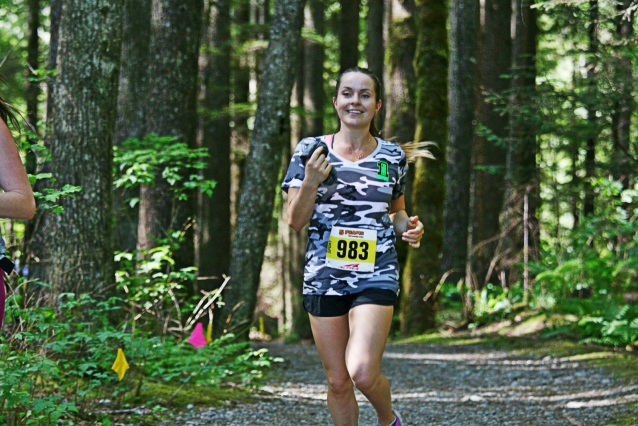Running for the Newbie
If you’re a looking to add more cardio into your weekly fitness regime, you’ve been persuaded by co-workers to join their annual charity run, or if you’re a complete beginner and the mere thought of running exhausts you, then this beginner’s running guide is for you!
Running is an excellent form of exercise and has plenty of health benefits such as weight loss, cardiovascular health and mental health. Ancient humans evolved running and it is one of the most basic human movement patterns. It is also thought to be the oldest ‘sport’ dating back to the very first Olympic Games. Today there are thousands of marathons and running events held each year in North America and millions of people who participate all over the world.
Running never interested me until this year when I was seeking to revamp my regular fitness program and needed some sort of athletic challenge again. I decided to join the Rep 1 Fitness trainers and clients at their annual 5 Peaks Trail run in Golden Ears Provincial Park earlier this year.
I was never a runner or a natural long distance cardio athlete. I tried running a handful of times but stopped well before any note worthy distance. Growing up a competitive gymnast I thought with the power in my legs and a good fitness background I would be able to run no problem. Think again! Long steady-state cardio like running was never part of our conditioning program in gymnastics and I soon found out I had to lose the ‘over confidence’ and learn how to run from scratch…
Tips for the running beginner!
-
Start Small and Build Up
The worst thing you can do for your body never-mind your confidence is to start off trying to run too much too soon. If you’ve never run before we recommend starting with two days per week with at least two rest days in between. Start slowly and monitor how you feel. You should be able to breath comfortably while running as if you were able to carry on a normal conversation. If you find your breathing is out of control, slow down or walk for a few minutes. The key is consistency! Consistent weekly runs will add up to longer distances, faster pace and superhero status in no time! Check out our sample program below!
-
Posture Posture Posture!
When you’re running think upright posture, shoulders relaxed and a slight forward lean. A slight forward tilt will place your centre of mass on the front part of your foot and avoid the heel striking first. This allows the foot and ankle to use its proper spring mechanic. Core should be strong and stable. Elbows in, arms gliding close to your sides – lets please avoid the dreaded chicken-wing-elbows-flailing-out-to-the-side technique!
Have a personal trainer at Rep 1 look at your form and running gait!
-
Use a Fitness Tracker
Use a fitness tracker app (there are literally hundreds to choose from!) on your phone or invest in a smart watch to track stats such as distance, pace, heart rate and calories burned.
Apps We Like:
-
Follow a Consistent Program
Below you’ll find a sample running program that gradually builds up from a 2 km run to a 1o km run. If you’re new to exercise visit your health care provider first to get cleared for running. If you’ve never run before we suggest building up your strength, endurance and running fitness base first. This can be done with walk/runs, alternating between walking and jogging intervals for 20 minutes a couple times a week. Specific strength training in the gym can also help build your running base and prevent injuries.
Sample 8 Week 10 Km Running Program
Cross Training (CT) refers to exercise like swimming, elliptical trainer or strength training. Remember running is the main goal here so do not exhaust yourself with overly intense cross training, it should be moderate and no longer than an hour. Make sure to always warm up first and cool down by walking and stretching after. After your first ‘big’ run your body will want to rest and recover for a few days, read our article on rest and recovery here.
| Monday | Tuesday | Wednesday | Thursday | Friday | Saturday | Sunday |
| Rest | 2 km walk/run | Cross Train or Rest | 2 km walk/run | Rest | 2.5 km walk/run | 20 minute run or cross train |
| Rest | 2.5 km walk/run | CT or Rest | 3 km walk/run | Rest | 3 km run | 25-30 min run or cross train |
| Rest | 3.5 km run | CT or Rest | 4 km walk/run | Rest | 4.5 km run | 30-35 minute run |
| Rest | 4 km run | CT or Rest | 4.8 km run | Rest | 5 km run | 35 minute run |
| Rest | 5 km run | CT or Rest | 5.5 km run | Rest | 6 km run | 35-40 minute run |
| Rest | 5 km run | CT or Rest | 5.5 km run | Rest | 7 km run | 40 minute run |
| Rest | 5.5 km run | CT or Rest | 6 km run | Rest | 8 km run | 40-45 minute run |
| Rest | 5 km run | CT or Rest | 3 km run | Rest | Rest | 10 km run! |
If you begin to enjoy running like I did and decide to do a trail run like the the 5 Peaks or one for charity like the family friendly CIBC Run for the Cure make sure you know the race course. If it includes any hills for example ensure to add some hills into your training runs.
Enough reading – let’s get running! Throw on some good running shoes, stay safe and happy running!


